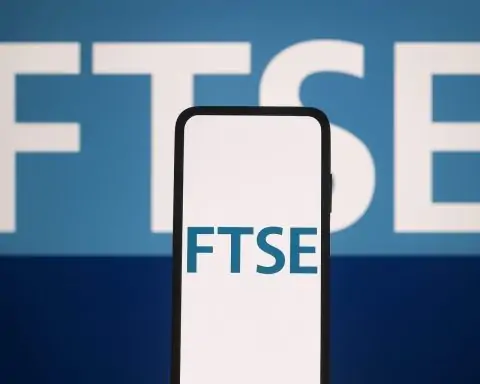- Markets rebound: European bourses clawed back losses on Friday (Sept 26), with the STOXX Europe 600 up ~0.8%, leaving the index roughly flat for the week [1]. Spain’s IBEX 35 jumped ~1.3%, while the UK’s FTSE 100, Germany’s DAX and France’s CAC 40 each rallied around 0.8–1% [2]. Major indices ended the period at or near multi-day highs, recouping earlier weakness.
- Tariff shock rebalanced: Investors digested U.S. President Trump’s surprise tariff hike on medicines, trucks and furniture. The initial selloff in healthcare and U.S.-exposed sectors largely reversed as market strategists noted the moves were “already priced in” [3] [4]. Industrial and financial stocks led gains: insurers like Munich Re and SCOR rose ~2%, and steelmakers (ArcelorMittal, ThyssenKrupp, Salzgitter) jumped 2–5% on reports the EU may slap counter-tariffs on Chinese steel [5].
- Star stock movers: Notable winners included InterContinental Hotels (+4% on JPMorgan upgrade) and Lufthansa (+3.4% on job-cut plans) [6] [7]. Healthcare (pharma) and heavy-truck makers lagged after tariff news [8] [9]. In Italy, luxury and consumer names (e.g. LVMH, Richemont) were buoyed by broader market optimism, though some retail stocks slumped on specific setbacks (as one Thomson Reuters analyst quipped, “we could be faced with a rocky road” ahead of UK and EU fiscal announcements [10]).
- Currencies move with risk bias: The euro held near one-year highs (roughly $1.17–1.18) as risk appetite improved, while the dollar dipped after strong U.S. data tempered expectations of Fed rate cuts [11]. The Swiss franc stayed strong following the Swiss central bank’s move to hold rates at 0% and warn that U.S. tariffs “are likely to dampen” Swiss growth [12] [13]. In contrast, the pound slid on UK fiscal worries: it hit two-month lows (~$1.33) and was set for its worst week since July [14] [15] as gilt yields spiked on weak economic data. Monex strategist Nick Rees noted that Britain’s loose fiscal outlook “isn’t sterling-positive” amid Fed‐related USD strength [16].
Index Performances: Broad Gains, Sector Rotation
European benchmarks climbed on Friday, shrugging off mid-week lows. The pan-European STOXX 600 closed +0.8% [17]. Country indices ended higher: Spain’s IBEX 35 led with ~+1.3%, the CAC 40 (France) +0.97%, the DAX (Germany) +0.87%, and the FTSE 100 (UK) +0.77% [18] [19]. Week-over-week, gains were modest – STOXX 600 was just 0.07% higher [20] – reflecting a recovery from tariff-led fears.
By sector, financials and industrials outperformed. European insurers (e.g. Munich Re, SCOR) jumped ~2% on the day [21], driven partly by dovish global rate signals and M&A chatter. Materials and industrial stocks rallied: Citigroup’s upgrade on Ireland’s Kingspan helped construction shares (+1.1%) [22], while steelmakers spiked 2–5% after Handelsblatt reported the EU is mulling 25–50% duties on Chinese steel [23]. Technology and luxury names saw moderate gains on easing rate fears, while energy and commodity sectors outperformed amid higher oil prices (Brent +1%) [24] [25]. Only autos and pharma closed slightly lower – auto-truck stocks fell on the 25% U.S. truck tariff, and drugmakers lost early buoyancy [26] [27].
Key Drivers: Tariffs, Fed Signals and Macro Data
Trump’s Tariff Threats. U.S. President Trump shocked markets with steep new levies – 100% on patented drugs and 25–50% on heavy trucks – effective Oct 1. Asian markets sold off on Thursday, but by Friday Europe rallied as investors conceded the announcements were mostly expected. Edmond de Rothschild’s Nabil Milali noted that “it was already priced in” for pharma, and that valuations already reflected tariff risks [28]. Financials rallied as the risk on tone returned – banks and insurers rose – while healthcare stocks ended flat after earlier losses [29].
U.S. Economic Data & Fed. Robust U.S. numbers (e.g. strong Q2 GDP and labour data) led a fed-funds reappraisal. The markets have cut their view of Fed easing: traders see only ~39 basis points of rate cuts by December, down from 125 bps expectations weeks ago [30]. Fed officials echoed caution. This helped U.S. bond yields rise (10-yr Treasuries up ~0.15%) and underpinned the dollar’s jump against major currencies [31] [32]. The net effect: mildly reduced the rally in global stocks and kept fixed-income yields on the up.
Eurozone News. The European Central Bank is on pause, but regional data have been mixed. Notably, Spain stands out – Q2 GDP came in at 3.1% annual growth (0.8% QoQ) – far above the almost flat euro-zone average [33]. Spain now officially forecasts 2.7% GDP growth for 2025 [34], the fastest in Western Europe. This strength (combined with an unemployment rate near 17-year lows) underpins the IBEX’s outperformance. In contrast, Germany and Italy contracted slightly in Q2. This uneven growth picture suggests country stock moves will diverge: cyclical and domestic plays in Spain/France may attract buyers, while Germany’s exporter-heavy DAX was buoyed by global recovery hopes.
Central Banks. Outside Europe, policy news also mattered. Switzerland’s SNB held rates at zero and warned that Trump’s tariffs will “dampen activity” [35]. The franc briefly weakened after the decision, with EUR/CHF ~0.9345 at week’s end [36], although strategists point out the SNB remains ready to cut again if deflation risks materialize [37]. In the UK, Bank of England commentary was light, but higher UK bond yields suggest markets demand more compensation for fiscal risk.
Sector/Stock Highlights
- Banks & Financials: European banks gained as yields ticked up and risk appetite returned. In the UK, Barclays and Lloyds led FTSE 100 bank stocks higher (Barclays rose ~3% on positive earnings outlook). Intermediation across the continent also firmed. Outside banks, InterContinental Hotels Group jumped 4% on a bullish JPMorgan upgrade [38], reflecting optimism in UK leisure travel.
- Industrials & Materials: Steel and construction surged. ArcelorMittal (+2.6%) and Germany’s Salzgitter (+5.2%) climbed on the EU-China steel tariff news [39]. Defense and aerospace names were mixed: Sweden’s Saab later fell on a BOFA downgrade (from Sept. 24, 2024 news), though some defence names took heart from rising budgets.
- Consumer/Luxury: Luxury goods firms gained modestly on the upbeat tone. LVMH and Richemont each added ~1.5–4%, as investors continue to bet on strong Chinese demand (driven by Beijing’s gradual stimulus). Retailers were mixed – UK homeware stock Dunelm slumped ~6% on a big shareholder exit (also reported on 9/24 [40]). Italian fashion makers had a rough week: Brunello Cucinelli fell another 1.7% after an activist attack (continuing an earlier slide) [41].
- Travel & Leisure: Airlines reacted to Lufthansa’s news. Reuters reported Lufthansa will cut “several thousand jobs” to improve efficiency [42], lifting its shares 3–4% [43]. Spohr, Lufthansa’s CEO, told employees they must become “leaner in admin” and invest in modern tech to improve margins [44]. RBC analyst Ruairi Cullinane cautioned that while cuts were necessary, investors will demand proof of hitting guidance: “Lufthansa should focus on what is immediately in front of it,” he said [45]. Similar themes may surface in other European airlines and travel companies.
Global Influences
- U.S. Monetary Policy: Fed signals continue to cast a shadow. With policymakers hesitant on further cuts amid inflation above target, risky assets in Europe may lack momentum without a clear catalyst. Markets now await Friday’s U.S. PCE inflation report and speeches by Fed officials (Powell on Tuesday), which could sway rate-cut bets and spill into European equities. One macro strategist noted the market’s focus on policy speeches as a source of direction in the short term [46].
- China’s Economy: Beijing’s authorities signaled readiness to ease policy. The People’s Bank of China vowed to “step up policy support” and coordinate with fiscal easing amid slowing growth [47]. Analysts still expect a broader stimulus package soon. Any firm action (e.g. rate cuts, infrastructure spending) would be a boon for Europe’s China-dependent sectors (autos, luxury, commodities). Indeed, past announcements lifted European luxury shares (LVMH, Richemont) and basic resources [48] [49]. Investors will watch closely for official stimulus details in coming weeks.
- Other Trends: Rising bond yields globally reflect stronger growth signals but weigh on rate-sensitive sectors. Commodity prices (oil, metals) were higher, modestly aiding energy and mining stocks. Geopolitical risks (e.g. Middle East tensions) remained in the backdrop but did not dominate market moves this week.
Currency Impacts on Stocks
- A stronger euro can dampen profits for exporters, but the cross-EU growth picture may offset that effect currently. Still, European exporters like luxury goods makers could feel margin pressure if the dollar weakens further.
- The pound’s decline lowers foreign earnings for UK-listed multinationals when converted back, but it also makes the FTSE 100’s high-dividend share prices cheaper for overseas buyers – a counterintuitive boost. Rabobank’s Jane Foley warned the approaching UK Budget could introduce taxes that “won’t be very friendly to investors” [50], adding to currency and equity caution.
- The Swiss franc’s strength often correlates with weakness in SNB-tracked sectors. Swiss stocks (healthcare, luxury, industrials) may feel earnings pressure from a strong franc, but SNB officials insist inflation is low enough to delay rate cuts [51], which at least anchors yields.
Analysts’ Take
Comments from strategists were mixed but insightful. Nabil Milali (Rothschild) reassured that the tariff slump in healthcare “was already priced in” [52]. State Street’s Marija Veitmane pointed out that a recent tech-led U.S. rally has taken global investors’ breath away, emphasizing that Europe’s stock rebound still lags behind (USD tech stocks are up ~24% since April) [53]. DWS strategist Madeleine Ronner said Europe’s valuations appear “more reasonable” than the U.S. as earnings start growing again, reducing the historic valuation gap [54]. On the flip side, UBS’s Max Castelli warned not to “rule out” an end to Europe’s outperformance era [55] amid global rotation.
Outlook: Cautious Optimism Ahead
As October begins, forecasts range from upbeat to wary. The immediate buzz on tariffs and strong earnings momentum may carry into the new quarter. If Eurozone inflation continues to cool (as some anticipate), the ECB might soon pause or cut rates, further supporting equities. In fact, some analysts expect the ECB to “pause its hikes” if inflation eases [56]. On the other hand, ongoing global uncertainties – geopolitical flare-ups, policy missteps or weaker-than-expected growth – could blunt the rally.
Investors will also keep an eye on the UK’s Budget and how Eurozone budget rules evolve amid record debt levels. As Monex’s Nick Rees cautioned, without solid fiscal rules, Europe could see volatility: “fiscal policy is not going to be dictated by the Treasury…it’s going to be dictated by bond markets” [57].
In summary, the European market story this week was one of regained footing amid mixed signals. Bullish forces (fiscal stimulus, easing inflation) are balancing bearish shocks (trade tensions, stretched equity multiples). The near-term trajectory may depend on upcoming data and policy signals, but for now the region’s indices have shown surprising resilience going into the October stretch.
Sources: Market data and analysis from Reuters and Investing.com financial news (stock moves and expert quotes) [58] [59] [60] [61] [62] [63], supplemented by official GDP and central bank reports [64] [65]. All insights credited to cited analysts and strategists.
References
1. www.investing.com, 2. www.investing.com, 3. www.investing.com, 4. www.investing.com, 5. www.investing.com, 6. www.investing.com, 7. www.reuters.com, 8. www.investing.com, 9. www.investing.com, 10. www.reuters.com, 11. www.reuters.com, 12. www.reuters.com, 13. www.reuters.com, 14. www.reuters.com, 15. www.reuters.com, 16. www.reuters.com, 17. www.investing.com, 18. www.reuters.com, 19. www.investing.com, 20. www.investing.com, 21. www.investing.com, 22. www.investing.com, 23. www.investing.com, 24. www.investing.com, 25. www.investing.com, 26. www.investing.com, 27. www.investing.com, 28. www.investing.com, 29. www.investing.com, 30. www.reuters.com, 31. www.reuters.com, 32. www.reuters.com, 33. www.reuters.com, 34. www.reuters.com, 35. www.reuters.com, 36. www.reuters.com, 37. www.reuters.com, 38. www.investing.com, 39. www.investing.com, 40. www.reuters.com, 41. www.investing.com, 42. www.reuters.com, 43. www.reuters.com, 44. www.reuters.com, 45. www.reuters.com, 46. www.reuters.com, 47. www.reuters.com, 48. www.reuters.com, 49. www.reuters.com, 50. www.reuters.com, 51. www.reuters.com, 52. www.investing.com, 53. www.reuters.com, 54. www.reuters.com, 55. www.reuters.com, 56. www.reuters.com, 57. www.reuters.com, 58. www.investing.com, 59. www.reuters.com, 60. www.reuters.com, 61. www.reuters.com, 62. www.reuters.com, 63. www.reuters.com, 64. www.reuters.com, 65. www.reuters.com










